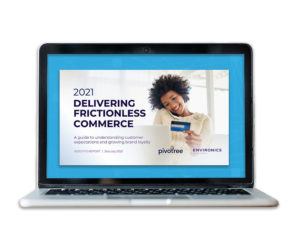A Capability Framework for Frictionless Thinking
As buying becomes increasingly digital, companies place greater emphasis on frictionless commerce. And for good reason — reducing a customer’s time and hassle to find, purchase, and receive your products will delight them and build loyalty amidst fierce competition.
What companies may not realize is that every customer-facing experience is a result of a well-oiled frictionless commerce machine on the back end. Creating and refining these back-end processes requires companies to shift their mindset to frictionless thinking.
Achieving that shift requires a Capability Framework built around defining, designing, executing, and operating their commerce system.
Today, we’ll elaborate on the Pivotree-designed framework, and show how our unique process makes us so effective at instilling frictionless thinking within an organization.
First, we build Empathy
When we start working with a company, we first gather knowledge from a variety of contributors in your ecosystem (subject matter experts, customers, business owners, etc.) but more importantly we build empathy for all the constituents in the business ecosystem. By understanding their needs, drivers, frustrations and dynamics we can better prioritize and align solutions. We then distill that knowledge and context into pain points. We take those pain points, rapidly develop them into business innovations, and then turn those innovations into Value Stories.
Then create Value Stories.
What is a Value Story? This narrative helps explain a project’s value to the various constituents involved — end customers, customers of your customers, your suppliers, etc. After compiling the list of Value Stories, we define each story’s impact across the business based on factors like the level of change, resources required, risk, timing, and urgency. Then we’ll rate them to see which we’ll implement, and in what order.
You may not want to implement a lot of long-term, high-capital initiatives at the same time. In that case, breaking up larger projects into smaller increments helps you achieve quick value wins.
Next, we turn Value Stories into Capabilities.
When we’re talking to companies about the Value Stories that would make the most impact across the business, we advise them to think in terms of organizational capabilities. That way, they’re encouraged to view the company holistically, not just individual silos.
Remember, your customers don’t see problems with your products in terms of divisions or departments (i.e., a procurement issue). They see company issues. So, solving those problems as a company is crucial.
Then, we guide you through Pivotree’s Capability Framework.
Our Capability Framework is utilized to determine whether a capability is required to deliver the Value Stories we prioritized. As we evaluate, we dive into each capability to systematically assess its potential impact, using a series of strategic steps.
1. Evaluate Your Capabilities
We’ll look at the current state of capabilities in your business, and evaluate whether each capability is:
- Non-Existent – your company does not have this capability in any form.
- Functional – you have the capability in its basic form.
- Competitive – the capability is adequate to compete against others in your space.
- Advanced – your company excels in this capability.
- Leader – you’re a market leader in this capability.
2. Benchmark Against Competitors
After evaluating where you stand with a particular capability, we’ll look at the competition as a benchmark. At this step, we ask: Is it valuable to increase this capability at this time, or would boosting different functions return more value?
3. Select Capability Type
Next, we’ll evaluate what this capability means to your organization. The type fits into three buckets: Utility, Core, or Strategic.
- Utility – the capability needs to be reliable, but you shouldn’t put a lot of effort into perfecting it. We’re looking for the quickest, least expensive solution.
- Core – the capability is valuable to your customers, but it’s something many competitors do as well. So, you want to ensure you stand out for delivering it reliably, accurately, and cost-effectively.
- Strategic – this is your secret sauce. If a capability is strategic, you want to put as much time and effort into expanding it. You’ll look at how you can connect the capability to other parts of the organization to increase the benefit.
4. Technology
At this point, we’ll dig into your technology, primarily focusing on two aspects: Data and Integrations.
- Data – is your data in the correct format? Is it accessible as a golden record that can support these capabilities?
- Integrations – Many companies still use spreadsheets to move data from one source to another. That’s a huge friction point (remember — we’re trying to remove friction), both in speed and accuracy. If you have bad data, you’ll risk giving customers poor recommendations or leading them to buy your products based on an incomplete understanding. You don’t always need to add new functionality. You can also clean up current integrations and improve data quality.
5. Ecosystem Constituents
We then look at the impact any changes may have on the constituents of your ecosystem, which includes three components: your core business, the extended enterprise, and the business ecosystem. We’ll evaluate how each constituent may be affected, positively or negatively, by the changes you’d like to make.
6. Change Management
Finally, we communicate and manage the change within your organization and throughout your ecosystem. We ensure everyone is aware of the changes (including the timing), so all constituents can immediately take advantage of this new capability.
Why should you adopt frictionless thinking?
Businesses like yours are laser-focused on staying agile and delivering the frictionless commerce experiences your customers demand. We know this requires a shift in mindset – but that mindset alone is not enough. Adapting relentlessly also takes a proven, systematic approach. Pivotree’s Capabilities Framework helps you knock out points of friction while taking on projects that create the greatest impact on your ecosystem.
To help companies shift to frictionless thinking, we’ve developed a research paper in partnership with Environics — Delivering Frictionless Commerce: A guide to understanding customer expectations and growing brand loyalty.
[hubspot type=form portal=239143 id=93f6fd5d-9fc7-4472-92b9-bc54392210dd]

